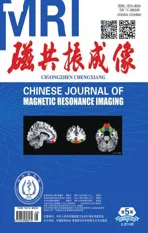磁共振准连续动脉自旋标记技术在不随意运动型脑瘫患者中的初步研究
2017-09-29韩秉艳玛依拉夏坎王皓贾文霄王云玲
韩秉艳,玛依拉·夏坎,王皓,贾文霄,王云玲
磁共振准连续动脉自旋标记技术在不随意运动型脑瘫患者中的初步研究
韩秉艳,玛依拉·夏坎,王皓,贾文霄,王云玲*
作者单位:新疆医科大学第二附属医院影像中心,乌鲁木齐 830063
目的 应用磁共振准连续动脉自旋标记(pseudo-continuous arterial spin labeling,pCASL)技术观察不随意运动型脑瘫患者脑部运动区(内囊后肢皮质脊髓束)的血流特点,通过血流变化来研究脑瘫患儿运动区的功能病理基础,为临床治疗效果及早期诊断提供影像支持。材料与方法 回顾性分析经临床诊断为不随意运动型脑瘫患者与志愿者各20例,观察不随意运动型脑瘫患者双侧内囊后肢皮质脊髓束运动区脑血流量的变化,通过t检验分析志愿者、患儿及志愿者与患儿双侧脑血流的的情况。结果 志愿者、不随意运动型脑瘫患者左、右两侧内囊后肢的皮质脊髓束运动区局部脑血流量差异有统计学意义(P<0.05),左侧脑血流量高于右侧。志愿者与脑瘫患者左、右两侧局部脑血流量比较差异有统计学意义(P<0.05),志愿者局部脑血流量高于不随意运动型脑瘫患者。结论 双侧内囊后肢功能运动区脑血流减低是导致不随意运动型脑瘫运动区的功能病理基础之一,可以通过磁共振pCASL技术对不随意运动型脑瘫运动区的血流量进行定量分析。
脑性瘫痪;内囊;磁共振成像
不随意运动型脑性瘫痪是锥体外系受损 引起的脑性瘫痪之一,它占所有脑瘫发病率的10%~30%,其导致的运动残疾程度往往较重,治疗难度较大[1]。临床表现主要表现为手足徐动、舞蹈样动作、震颤等。笔者应用磁共振准连续动脉自旋标记(pseudo-continuous arterial spin labeling,pCASL)技术对不随意型运动型脑瘫患者双侧内囊后肢区域脑血流量 (regional cerebral blood flow,rCBF)进行初步研究,研究脑瘫患儿运动区的功能病理基础,通过该区域脑血流的变化为临床治疗效果进行评价,同时为常规MRI表现为阴性患者早期诊断提供影像支持,使患者得到及时诊断及相应治疗。
1 材料与方法
1.1 一般资料
搜集本院2016年5月至10月被临床诊断为不随意运动型脑瘫患者20例,志愿者20例,年龄4~15岁,平均年龄6岁。志愿者均为右利手。
1.2 方法
1.2.1 仪器与扫描方法
使用Philips公司3.0 T聚源磁共振16通道头颅线圈,所有不配合患者经水合氯醛灌肠后进行检查。先进行短激发 T1WI、T2WI 序列扫描后进行pCASL扫描,全部扫描时间约为7 min。具体参数:TR 4000 ms,TE 15 ms, FOV 240 mm×240 mm,层数16,层厚5.0 mm,层间距1 mm。感兴趣区(ROI)为双侧内囊后肢后3/4处,面积约为16 mm×16 mm,同一部位测量三次,取平均值进行统计学分析。
1.2.2 统计方法
用SPSS 19.0软件包对脑瘫患者组及正常志愿者对照组所测量的双侧内囊后肢rCBF值进行统计分析,各组数据采用表示,先进行正态性检验,再进行配对及独立样本t检验进行分析比较,P<0.05为差异有统计学意义。
2 结果
志愿者、脑瘫患者左、右两侧内囊后肢的皮质脊髓束运动区局部脑血流量有差异性(P<0.05),左侧局部脑血流量高于右侧。志愿者与脑瘫患者双侧内囊后肢局部脑血流量比较差异有统计学意义(P<0.05),志愿者高于脑瘫患者(表1,2;图1)。
3 讨论
不随意运动型脑瘫主要是由锥体外系损伤引起的。锥体外系统主要是指基底神经节(基底核),各核团之间通过神经纤维和神经递质相联系,为自主运动所必需的肌张力和姿势做好准备。以基底节为主的锥体外系受损可引起随意运动障碍而不随意运动增多,表现为扭转痉挛张力障碍,舞蹈及手足徐动等症状。不随意运动型脑瘫的主要病因为缺氧缺血性脑损伤和胆红素脑病,病变主要在基底神经节区[2-3]。也有文献报道,部分原因造成脑损伤可选择性损伤苍白球[4],在双侧内囊后肢后3/4处(相当于苍白球的后缘水平)为皮质脊髓束所在区域,该区域受损会影响神经纤维的传导,从而会引起相关临床症状。
笔者通过PCASL研究不随意运动型脑瘫患者该区域的血流情况,rCBF值具有明确的临床及生理学意义,是临床工作中认可度较高的常用检查技术[5],它结合了连续式 ASL 和脉冲式 ASL 优点,是一种全新无创容积灌注成像技术[6],它的短脉冲能够减少受检者的能量吸收率,同时还可以减轻磁化转移效应,采集时间更短,能有效克服磁敏感及运动伪影,大大提高了图像信噪比和标记效率,灌注图像更均匀[7-8]。Gevers等[9]对10例健康志愿者在3个影像中心均进行pCASL、CASL和PASL检查,结果发现pCASL联合背景抑制法得到的数据差异性最小。目前关于pCASL的应用相关研究较多,主要应用在成人脑血管性病变、肿瘤性病变及阿尔茨海默病等中枢系统疾病较多[10-14],而在脑瘫患儿中的应用研究十分少见。笔者通过对志愿者与不随意运动型脑瘫内囊后肢后3/4处局部脑血流的研究初步探讨脑瘫患儿的局部脑血流情况,在研究中发现正常儿童左、右两侧内囊后肢后3/4处血流情况左侧局部血流高于右侧,P<0.05,差异有统计学意义,可能的原因是本研究全部受试者均为右利手,长期的右手运动导致左侧脑神经活动增强,从而引起左侧血流量选择性增加有关,这与刘世文等[15]手部运动可以导致脑血流相对增加的结果基本一致。另外,本研究中发现不随意型脑瘫患者左、右两侧内囊后肢后 3/4处区域性脑血流是有差别的,P<0.05,左侧脑血流还是高于对侧,这与志愿者局部血流表现基本一致,这是否与脑瘫患儿大脑本身脑血流灌注有关还有待进一步研究,但其与正常人比较,左、右两侧脑血流量是有差别的,P<0.05,患者左、右两侧脑血流均低于正常组,脑血流量的减低导致该区域的神经纤维的发育不全或缺失从而导致锥体外系传导通路的损伤从而造成脑损伤,引起患儿的不随意运动增加,这也说明双侧内囊后肢后3/4处区域的脑血流对锥体外系传导有着很重要的意义,也是导致不随意运动型脑瘫患者发病的因素之一。通过测量局部脑血流的变化,特别是在MRI常规扫描表现为阴性的患者,pCASL更能够检测到异常,其测量结果则更有意义,但也有局限性,由于研究对象为脑瘫患儿,体位及脑部病变存在差异较大,这可能会影响部分测量的真实性,需在今后的研究中对脑部影像表现为阴性的患儿进行专门研究,来弥补这方面的缺陷,再者还需要增加样本量来进行进一步定量研究,从而为临床不随意运动型脑瘫患儿运动区的功能病理基础及早期诊断及治疗提供可靠的影像支持。

表1 正常组、患者组双侧内囊后肢rCBF比较Tab.1 Normal group, the patient group bilateral internal capsule hind limb rCBF comparison

表2 双侧内囊后肢患者于正常组间的rCBF比较Tab. 2 Comparison of rCBF between the bilateral hind limb patients and the normal group

图1 患者,女,5岁。肢体功能障碍并智力低下4年。A、B为ADC图,A:患者诊断为左侧顶叶脑裂畸形,左顶叶增宽的脑沟与左侧侧脑室相通;B:感兴趣区选择双侧内囊后肢后3/4处,信号相对较高的部位;C:pCASL原始图;D:伪彩图,左侧感兴趣区血流量低于右侧,红色为高灌注区,右侧感兴趣区红色范围明显大于左侧Fig. 1 Female, 5 years old, and limb dysfunction and mental retardation for 4 years, A, B: ADC figures. A: Patient with left parietal lobe cleft, sulcus and left lateral ventricle with left parietal lobe broadening. B: Region of interest selection of bilateral posterior limb of the internal capsule 3/4, signal relatively high position. C: pCASL figure. D: The original pseudo color, the left side of blood flow in the region of interest was lower than the right, red for high perfusion area, right ROI red range was signi ficantly larger than the left.
pCASL技术不仅可以对全脑灌注还可以对区域性血流灌注进行定量分析,其作为一种无创的影像学检查方法将对脑瘫的血流动力学研究有着十分重要的价值。
[References]
[1] Li XJ, Tang JL, Ma BX et al. The definition of cerebral palsy,diagnostic criteria and clinical classification. Chin J Appl Clin Pediatr, 2014, 29(19): 1520.李晓捷, 唐久来, 马丙祥, 等. 脑性瘫痪的定义、诊断标准及临床分型. 中华实用儿科临床杂志, 2014, 29(19): 1520.
[2] Ahlfors CE, Wennberg RP, Ostrow JD, et al. Unbound (free)bilirubin: improving the paradigm for evaluating neonatal jaundice.Clin Chem, 2009, 55(7): 1288-1299.
[3] Johnston MV,Hoon AH Jr. Possible mechanisms in infants for selective basalganglia damage from asphyxia, kemicterus, or mitochondrial encephalopathies. J Child Neurol, 2000, 15(9):588-591.
[4] Sugama S, Soeda A, Eto Y. Magnetic resonance imaging in three with children kernicterus. Pediatric Neurolog, 2001, 25(4): 328-331.
[5] Zhu YF, Lu Q, Li GQ, et al. Feasibility of applying arterial spin labeling to the study of post - acupuncture fMRI. Chin J Comb Trad Chin West Med Imag, 2016, 14(4): 373-375.朱一芳, 卢琦, 李国强, 等. 动脉自旋标记技术在针刺fMRI后效应研究中的可行性分析. 中国中西医结合影像学杂志, 2016, 14(4):373-375.
[6] Huang D, Wu B, Shi K, et al. Reliability of three-dimensional pseudo-continuous arterial spin labeling MR imaging for measuring visual cortex perfusion on two 3 T scanners. PLoS One, 2013, 8(11):e79471.
[7] Wheaton AJ, Miyazaki M. Non-contrast enhanced MR angiography:physical principles. Magn Reson Imaging, 2012, 36(2): 286-304.
[8] Wu H, Block WF, Turski PA, et al. Noncontrast-enhanced three-dimensional (3D) intracranial MR angiography using pseudocontinuous arterial spin labeling and accelerated 3D radial acquisition. Magn Reson Med, 2013, 69(3): 708-715.
[9] Gevers S, van Osch MJ, Bokkers RP, et a1. Intra- and muhicenter reprod- ucibility of pulsed, continuous and pseudo-continuous arterial spin labeling methods for measuring cerebral perfusion. J Cereb Blood Flow Metab, 2011, 31(8): 1706-1715.
[10] Wolk DA, Detre JA. Arterial spin labeling MRI: an emerging biomarker for Alzheimer's disease and other neurodegenerative conditions. Curr Opin Neurol, 2012, 25(4): 421-428.
[11] Binnewijzend MA, Kuijer JP, Benedictus MR, et al. Cerebral blood flow measured with 3D pseudocontinuous arterial spin-labeling MR imaging in Alzheimer disease and mild cognitive impairment: a marker for disease severity. Radiology, 2013, 267(1): 221-230.
[12] Chen W, Song X, Beyea S, et al. Advances in perfusion magnetic resonance imaging in Alzheimer's disease. Alzheimers Dement, 2011,7(2): 185-196.
[13 ] Ozsunar Y, Mullins ME, Kwong K, et al. Glioma recurrence versus radiation necrosis? A pilot comparison of arterial spin-labeled,dynamic susceptibility contrast enhanced MRI, and FDG-PET imaging. Acad Radiol, 2010, 17(3): 282-290.
[14] Hendrikse J, Petersen ET, Golay X. Vasculardisorders: insights from arterial spin labeling. Neuroimaging Clin N Am, 2012, 22(2):259-269.
[15] Liu SW, Lü Z, Liu YJ, et al. A study of CBF of the cortical area activated by simple hand motor performance in normal subject as revealed by SPECT. Chin J phys Med Rehabil, 2014, 26(11):671-674.刘世文, 吕政, 刘亚杰, 等. 正常人手指简单运动时脑功能区被激活的SPECT脑血流研究. 中华物理医学与康复杂志, 2014, 26 (11):671-674.
The preliminary study of magnetic resonance pCASL technique in dyskinetic cerebral palsy patients
HAN Bing-yan, Mayila·Xiakan, WANG Hao, JIA Wen-xiao, WANG Yun-ling*
Department of Radiology, the Second Affiliated Hospital of Xinjiang Medical University, Urumchi 830028, China
*Wang YL, E-mail: 2824059816@qq.com
Objective: To observe the blood flow characteristics of brain movement area (posterior capsule cortex spinal cord bundle) in patients with involuntary movement of cerebral palsy by magnetic resonance pseudo-continuous arterial spin labeling(pCASL). To study the functional and pathological basis of the motor area of children with cerebral palsy by blood flow changes, and to provide the image support for clinical treatment and early diagnosis. Materials and Methods: Retrospective analysis of the clinical diagnosis of dyskinetic cerebral palsy patients and normal volunteers 20 cases,respectively, observed the change of dyskinetic cerebral palsy patients with bilateral posterior corticospinal motor area of cerebral blood flow, cerebral blood flow analysis of local motion area. t test was used to analyze the cerebral blood flow of bilateral cerebral blood flow in volunteers, children, volunteers and children. Results: There were signi ficant differences in local cerebral blood flow and corticospinal motor area volunteers dyskinetic cerebral palsy patients with left and right sides of the posterior limb of the internal capsule (P<0.05), left cerebral blood flow was higher than right.There was significant differences in cerebral blood flow between the left and right side of the patients with cerebral palsy (P<0.05). Conclusions: The function of motor area of cerebral blood flow to reduce the bilateral posterior limb of the internal capsule which is one of the basic functions of pathological dyskinetic cerebral palsy movement area, can make quantitative analysis on the blood flow through magnetic resonance pCASL technique of dyskinetic cerebral palsy movement area analysis.
Cerebral palsy; Internal capsule; Magnetic resonance imaging
Received 22 Dec 2016, Accepted 22 Mar 2017
王云玲,E-mail:2824059816@qq.com
2016-12-22
接受日期:2017-03-22
R445.2;R742
A
10.12015/issn.1674-8034.2017.05.002
韩秉艳, 玛依拉·夏坎, 王皓, 等. 磁共振准连续动脉自旋标记技术在不随意运动型脑瘫患者中的初步研究. 磁共振成像, 2017, 8(5): 327-330.
